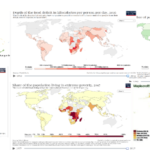Planning for Sustainability: Towards a Role for Evaluations and Measurement in Planning Exit Strategies
What We Know About Exit Strategies – Practical Guidance For Developing Exit Strategies in the Field
This document explores different types of exit strategies, provides guidance on how practitioners can develop these strategies, and also discusses the role that monitoring and evaluation can play in determining if an exit strategy worked well or not.
Reference: Alison Gardner, Kara Greenblott and Erika Joubert. C-SAFE Regional Learning Spaces Initiative. (2005). “What We Know About Exit Strategies – Practical Guidance For Developing Exit Strategies in the Field”.
Contexts, Trajectories, and Assessing Progress Towards Goals
Classifying Sustainable Development Goal trajectories: A country-level methodology for identifying which issues and people are getting left behind
This paper provides a framework to asses a country’s progress towards meeting the SDGs, with a focus on “leaving no one behind”. The paper discusses which SDGs are quantitatively assessable, and provides an approach to utilizing proxy targets if needed. Given a country’s unique context, the indicators can be classified based on their trajectory towards meeting a goal: on track; acceleration needed; breakthrough needed; moving backwards.
Reference: John McArthur, and Krista Rasmussen. (2019). “Classifying Sustainable Development Goal trajectories: A country-level methodology for identifying which issues and people are getting left behind.” World development 123 (2019): 104608.
Measuring Coherence of Complex Interventions
Evaluation to connect national priorities with the SDGs
This guide explores the role that evaluations can play in aligning national policies with the SDGs. Some topics covered in this document include identifying the overall objective of an evaluation; preparing for an SDG evaluation; and integrating the SDGs into a country’s national monitoring and evaluation system. The guide also offers examples of potential evaluation questions, some of which are focused on coherence and integration.
Reference: Stefano D’Errico, Tighe Geoghegan, and Ilenia Piergallini. (2020).
“Evaluation to connect national priorities with the SDGs. A guide for evaluation commissioners and managers”. IIED, London.
Navigating Spectacular Ambitions: The Role of Evaluations to Ensure the Sustainable Development Goal of “No One Left Behind”
Evaluating the Sustainable Development Goals With a “No one left behind” lens through equity-focused and gender-responsive evaluations
This document proposes the utilization of an equity-focused and gender responsive (EFGR) framework to evaluate the Sustainable Development Goals. It provides strategies on how to integrate equity and gender responsive principles into national evaluation systems.
Reference: Michael Bamberger, Marco Segone and Florencia Tateossian (2016).
“Evaluating the Sustainable Development Goals with a “No one left behind” lens through equity-focused and gender-responsive evaluation”.


